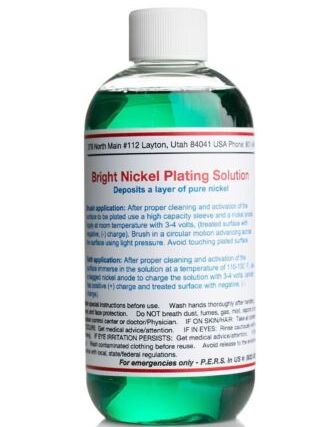
-----
Nickel Plating Antique Wood Stove is Unsuccessful
Q. Beginner
-
Restoring rusted wood stove with Nickel parts on outside: Handles, Cleanouts. Air Damper, Side Wings, etc.
Tried the simple, clean, white vinegar (5%), kosher salt, and DC voltage (4 volts) method as seen on You Tube, with no nickel transfer.
-
I then tried the electronic clean and it worked great, distilled water, white vinegar (5%), Boric acid, sulphonic acid, submerged circulation solution pump, PH testing strips, submerged solution heater, and no luck.
-
Materials details:
Clear Plastic tub 10" X 20".X 5" deep.
2 Gallons fresh White Vinegar (5%)
1/2-gallon distilled water (to get solution to pH 4 from pH 3)
2 Pure 1' by 5" Nickel Ribbons used as Anode
Circulator submerged pump (50 Gals / hr.)
AC/DC Power supply (6 Volts / 1 Amp)
Kosher Salt 1 Tablespoon.
Solution heater (varied 129 to 134 °F)
8 oz Boric acid
10 oz Taylor Sulfuric acid (1%)
-
Prepared solution with Nickel Anodes and Cathodes until solution was green 12 hrs., Negative connected to Plating object, Positive connected to double Nickel ribbon Anode, 2 Hr. bath try, Monitored pH at 4 and Temperature 129 to 134 °F, 1/2 " bubbles ( 60 to 70 per minute), lots of clouding through the whole time.
--
Attached is a picture of results. The lighter colored one is what it looked like before and the dark one is the results. This piece is about 12 " by 4". Now looks burnt.
-
Zero nickel transfer. What is going on?
Beginner restorer - Hooper, Utah
October 6, 2025
A. Hi Vern,
Sorry but we haven't received any pictures yet -- please attach them to e-mail to mooney@finishing.com
We don't want to discourage you from your hobby and your efforts at nickel plating yourself -- by all means enjoy it! -- but we also don't want to mislead other readers into thinking that this is the usual way to get parts plated, so here are some preambles ...
Firstly, plating job shops can be found quite nearby in most areas, and nearly every plating shop offers nickel plating, so having parts professionally nickel plated is the usual approach.
Secondly, although this site has been teaching elementary school children how to electroplate with kitchen ingredients for relatively safe science projects since 1995, that has been for the purpose of allowing them to see electroplating take place to inspire a thirst for understanding which we can help them take further with such subjects as Faraday's Law.
Functional electroplating is not done with vinegar and salt or by dissolving metal into them, etc. Rather, nickel plating is done by purchasing a "Watts nickel plating solution" from a vendor, or formulating it. The plating solution will have proper amounts of nickel sulfate, nickel chloride, boric acid, wetters, carriers, and brighteners to deposit a robust, reasonably thick, relatively low stress, bright, corrosion-resistant deposit based upon many decades of research and development.
9th Edition, Vol. 5
"Surface Cleaning, Finishing & Coating"

on eBay or Amazon
or AbeBooks
(affil link)
Hobbyists who are interested specifically in nickel plating are encouraged to get access to ASM's Metals Handbook Vol. 5, "Surface Cleaning, Finishing, and Coating" ⇨
because it has a fairly comprehensive chapter explaining nickel plating and its addition agents. It is a great help for readers who want to achieve the best plating that is possible without proprietary ingredients.
The first thing a hobbyist should be told is that you don't practice on precious parts and risk ruining them. You practice on scrap, and you only go on to actual parts after you have demonstrated to yourself that things are sufficiently under control. If you want to grow from playing around to working seriously, you get a Hull Cell
⇦ on
eBay
or
Amazon [affil link] , some test panels for it, and a proper power supply
⇦ on
eBay or
Amazon [affil link] ... sounds like you already have the power supply (how many Amps is it?)
Readers will probably be happy to help you step by step, Wheatley, but the idea that your first exercise will result in successful nickel plating of an old 12" x 4" part using a home-brew of household ingredients simply isn't realistic. If nothing else please start with a test panel ⇦ on
eBay
or
Amazon [affil link] because it will be properly prepared and small enough that you will be able to see the capability or lack of capability of your solution. I can't imagine 10 oz. of 1% sulfuric acid doing anything at all in 3 gallons of solution unless you're a strong proponent of homeopathic dilution.
Luck & Regards,

Ted Mooney, P.E. RET
Striving to live Aloha
finishing.com - Pine Beach, New Jersey
Ted is available for instant help
or longer-term assistance.
![]() Thank you. This is the first information that I have read that really makes sense.
Thank you. This is the first information that I have read that really makes sense.
You asked about my power supply. It delivers up to 30 volts and 5 Amps. I had to raise the voltage to 6 to get 1 Amp of current. I understand that is too much voltage.
hobbyist - Hooper, Utah
October 10, 2025
A. Hi again.
That's a good power supply for rather small parts. You don't need to electroplate to industrial parameters, but just to give you a sense of things, bright nickel plating plating is done at 40 Amps per square foot. So you will only be able to do actual bright nickel plating on 5 X 144/40 = about 18 square inches (and that's both sides). You can plate at quite a bit lower current density, but will have to buff the parts to get brightness. If you can put plater's tape (or at least black electrical tape) on the backs of the parts you'll reduce the surface area you are plating and increase the plating speed on what you do want to plate.
You should be able to find a handful of brass test panels on eBay or somewhere, and you can cut them in half to stretch your money, and that's really the first step towards getting your solution working. But I think you will have to add some nickel sulfate
⇦ on
eBay or
Amazon [affil link]
or nickel chloride before you'll get much going; real nickel plating solution is rich emerald green, having far more nickel in it than you've probably achieved by anode dissolution.
Luck & Regards,

Ted Mooney, P.E. RET
Striving to live Aloha
finishing.com - Pine Beach, New Jersey
Ted is available for instant help
or longer-term assistance.
Q, A, or Comment on THIS thread -or- Start a NEW Thread
